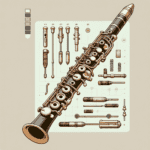The clarinet has a rich history, and with it comes a fascinating evolution in key placements that have distinctly influenced how the instrument is played today. From its inception in the 18th century to the modern designs we know, understanding historical clarinet key placement can truly open your eyes to the artistry and mechanics behind this instrument.
A Journey Through Time: The Evolution of Clarinet Key Placement
Let's explore this journey through time! The clarinet's early prototypes, primarily made from wood, had a simple key system. The keys were basic, mainly allowing for the most fundamental notes. This design was limiting and certainly didn't allow players to fully express their artistry.
As we move to the late 18th century, the clarinet began to change. The renowned clarinet maker, Johann Christoph Denner, played a crucial role in this development. He introduced what we now recognize as the modern clarinet in 1700. Adding more keys improved playability, giving musicians the freedom to tackle more complex pieces. However, the placement of these keys was experimental and varied from maker to maker, leading to a diverse range of designs. It was like a musical Wild West!
Timeline: Key Developments in Clarinet History
- 1700: Johann Christoph Denner introduces the modern clarinet
- 1830s: Theobald Boehm develops the Boehm system
- 19th century: Widespread adoption of the Boehm system
- 20th century: Introduction of synthetic materials and further key layout refinements
The Boehm System: A Revolution in Key Placement
The 19th century brought about significant developments with the introduction of various key mechanisms, notably the Boehm system. Developed by Theobald Boehm in the 1830s, this system transformed not just the clarinet, but woodwind instruments as a whole. The placement of keys allowed for smoother transitions between notes, more fluid scales, and increased technical capabilities. Players were no longer held back by the limitations of their instrument.
Many clarinet designs after Boehm, including those by Martin Freres, fully embraced this system. With the adoption of Boehm's innovations, clarinetists could hit notes with remarkable agility! The new key placement changed not only how the instrument was played but also how it sounded. The tonal quality improved significantly, with players able to achieve a wider range of dynamics.
Modern Refinements: The 20th Century and Beyond
As we entered the 20th century, the clarinet saw even more improvements, particularly with the introduction of synthetic materials for pads and further evolution of key layouts. The use of these materials improved durability and ease of maintenance, allowing clarinetists to focus on their music rather than their instruments' quirks. Today's clarinet has numerous keys, each carefully positioned to ensure a smooth playing experience. The way keys interact allows for clean fingerings that experienced players value.
Key Features of Modern Clarinets
- Numerous precisely placed keys
- Synthetic materials for improved durability
- Enhanced key layouts for better fingering
- Improved tonal quality and range
- Greater technical capabilities
The Importance of Understanding Key Placement
For today's players, grasping historical clarinet key placement is valuable. It helps us better master techniques and explore our instruments' capabilities. Simply put, key arrangement affects both the technical aspects and our artistic expression. Every key we press, every note we play, echoes the craftsmanship developed over centuries.
If you're new to the clarinet, or perhaps familiar with a specific model, you might wonder how these historical changes apply to you. The good news is that this legacy continues. Brands like Martin Freres showcase this commitment to excellence in design and placement. While the craft has evolved, the essence of clarinet playing remains rooted in this fascinating history.
Understanding the dynamics of your instrument could be the key to elevating your playing. By grasping how key placement influences your sound, you'll be well on your way to creating the beautiful music you've always dreamed of. Remember, every key is an opportunity waiting to be explored!
Conclusion: The Ongoing Legacy of Clarinet Key Placement
Let's not forget, passion and practice are key to mastering the clarinet. Whether you're just starting or refining advanced techniques, remember to appreciate the history built into the instrument you hold. Each note you play carries the stories of countless musicians before you – and who knows, you might just add your own chapter to this ongoing story of clarinet key placement!







